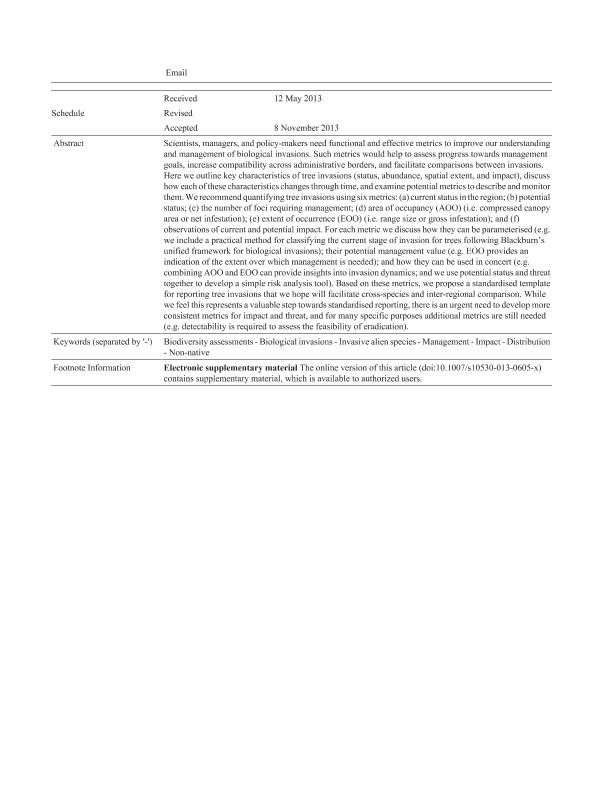Mostrar el registro sencillo del ítem
dc.contributor.author
Wilson, John R. U.
dc.contributor.author
Caplat, Paul
dc.contributor.author
Dickie, Ian A.
dc.contributor.author
Hui, Can
dc.contributor.author
Maxwell, Bruce D.
dc.contributor.author
Nuñez, Martin Andres

dc.contributor.author
Pauchard, Anibal
dc.contributor.author
Rejmanek, Marcel
dc.contributor.author
Richardson, David M.
dc.contributor.author
Robertson, Mark P.
dc.contributor.author
Spear, Dian
dc.contributor.author
Webber, Bruce L.
dc.contributor.author
Van Wilgen, Brian W.
dc.contributor.author
Zenni, Rafael D.
dc.date.available
2017-01-25T18:18:08Z
dc.date.issued
2014-01
dc.identifier.citation
Wilson, John R. U.; Caplat, Paul; Dickie, Ian A.; Hui, Can; Maxwell, Bruce D.; et al.; A standardized set of metrics to assess and monitor tree invasions; Springer; Biological Invasions; 16; 3; 1-2014; 535-551
dc.identifier.issn
1387-3547
dc.identifier.uri
http://hdl.handle.net/11336/11896
dc.description.abstract
Scientists, managers, and policy-makers need functional and effective metrics to improve our understanding and management of biological invasions. Such metrics would help to assess progress towards management goals, increase compatibility across administrative borders, and facilitate comparisons between invasions. Here we outline key characteristics of tree invasions (status, abundance, spatial extent, and impact), discuss how each of these characteristics changes through time, and examine potential metrics to describe and monitor them. We recommend quantifying tree invasions using six metrics: (a) current status in the region; (b) potential status; (c) the number of foci requiring management; (d) area of occupancy (AOO) (i.e. compressed canopy area or net infestation); (e) extent of occurrence (EOO) (i.e. range size or gross infestation); and (f) observations of current and potential impact. For each metric we discuss how they can be parameterised (e.g. we include a practical method for classifying the current stage of invasion for trees following Blackburn?s unified framework for biological invasions); their potential management value (e.g. EOO provides an indication of the extent over which management is needed); and how they can be used in concert (e.g. combining AOO and EOO can provide insights into invasion dynamics; and we use potential status and threat together to develop a simple risk analysis tool). Based on these metrics, we propose a standardised template for reporting tree invasions that we hope will facilitate cross-species and inter-regional comparison. While we feel this represents a valuable step towards standardised reporting, there is an urgent need to develop more consistent metrics for impact and threat, and for many specific purposes additional metrics are still needed (e.g. detectability is required to assess the feasibility of eradication).
dc.format
application/pdf
dc.language.iso
eng
dc.publisher
Springer

dc.rights
info:eu-repo/semantics/openAccess
dc.rights.uri
https://creativecommons.org/licenses/by-nc-sa/2.5/ar/
dc.subject.classification
Ecología

dc.subject.classification
Ciencias Biológicas

dc.subject.classification
CIENCIAS NATURALES Y EXACTAS

dc.title
A standardized set of metrics to assess and monitor tree invasions
dc.type
info:eu-repo/semantics/article
dc.type
info:ar-repo/semantics/artículo
dc.type
info:eu-repo/semantics/publishedVersion
dc.date.updated
2016-12-12T14:21:31Z
dc.journal.volume
16
dc.journal.number
3
dc.journal.pagination
535-551
dc.journal.pais
Alemania

dc.journal.ciudad
Berlin
dc.description.fil
Fil: Wilson, John R. U.. Kirstenbosch National Botanical Gardens; Sudáfrica. Stellenbosch University; Sudáfrica
dc.description.fil
Fil: Caplat, Paul. Lund University; Suecia
dc.description.fil
Fil: Dickie, Ian A.. Crown Research Institutes. Landcare Research; Nueva Zelanda. Lincoln University; Nueva Zelanda
dc.description.fil
Fil: Hui, Can. Stellenbosch University; Sudáfrica
dc.description.fil
Fil: Maxwell, Bruce D.. State University Of Montana; Estados Unidos
dc.description.fil
Fil: Nuñez, Martin Andres. Consejo Nacional de Investigaciones Científicas y Técnicas. Centro Científico Tecnológico Patagonia Norte. Instituto de Investigación en Biodiversidad y Medioambiente; Argentina. Universidad Nacional del Comahue; Argentina
dc.description.fil
Fil: Pauchard, Anibal. Universidad de Concepción; Chile
dc.description.fil
Fil: Rejmanek, Marcel. University of California; Estados Unidos
dc.description.fil
Fil: Richardson, David M.. Stellenbosch University; Sudáfrica
dc.description.fil
Fil: Robertson, Mark P.. University of Pretoria; Sudáfrica
dc.description.fil
Fil: Spear, Dian. Kirstenbosch National Botanical Gardens; Sudáfrica. Stellenbosch University; Sudáfrica
dc.description.fil
Fil: Webber, Bruce L.. University of Western Australia; Australia. CSIRO Ecosystem Sciences; Australia
dc.description.fil
Fil: Van Wilgen, Brian W.. Stellenbosch University; Sudáfrica
dc.description.fil
Fil: Zenni, Rafael D.. University Of Tennessee; Estados Unidos
dc.journal.title
Biological Invasions

dc.relation.alternativeid
info:eu-repo/semantics/altIdentifier/url/http://link.springer.com/article/10.1007/s10530-013-0605-x
dc.relation.alternativeid
info:eu-repo/semantics/altIdentifier/doi/http://dx.doi.org/10.1007/s10530-013-0605-x
Archivos asociados
